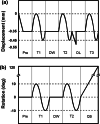Needle puncture injury of the rat intervertebral disc affects torsional and compressive biomechanics differently
- PMID: 20544231
- PMCID: PMC2997207
- DOI: 10.1007/s00586-010-1473-z
Needle puncture injury of the rat intervertebral disc affects torsional and compressive biomechanics differently
Erratum in
- Eur Spine J. 2011 Apr;20(4):667
Abstract
Needle puncture is a common method of inducing intervertebral disc (IVD) degeneration in small animal models and may have some similarities to IVD injury conditions such as herniation. Yet, the influence of puncture injuries on IVD biomechanics is not well understood. This study quantified the acute effects of anular injury on the biomechanics of rat caudal IVDs in compression and torsion following puncture with 30, 25 and 21 G needles. In compression, puncture injury reduced elastic stiffness by 20% for all needle sizes, but differences between control and punctured discs did not remain after compressive overload. In contrast, torsional parameters associated with anular fiber tension were affected proportionally with needle size. We conclude that IVD injuries that penetrate through the thickness of the annulus affect IVD biomechanics through different mechanisms for compression and torsion. Anular injuries affect torsional properties in a manner directly related to the amount of fiber disruption and compressive properties in a manner that affects pressurization.
Figures





Similar articles
-
Height and torsional stiffness are most sensitive to annular injury in large animal intervertebral discs.Spine J. 2012 May;12(5):425-32. doi: 10.1016/j.spinee.2012.04.001. Epub 2012 May 22. Spine J. 2012. PMID: 22627276 Free PMC article.
-
Biomechanical test protocols to detect minor injury effects in intervertebral discs.J Mech Behav Biomed Mater. 2019 Jul;95:13-20. doi: 10.1016/j.jmbbm.2019.03.024. Epub 2019 Mar 29. J Mech Behav Biomed Mater. 2019. PMID: 30947120 Free PMC article.
-
Sex Differences in Rat Intervertebral Disc Structure and Function Following Annular Puncture Injury.Spine (Phila Pa 1976). 2019 Sep;44(18):1257-1269. doi: 10.1097/BRS.0000000000003055. Spine (Phila Pa 1976). 2019. PMID: 30973506 Free PMC article.
-
Role of biomechanics in intervertebral disc degeneration and regenerative therapies: what needs repairing in the disc and what are promising biomaterials for its repair?Spine J. 2013 Mar;13(3):243-62. doi: 10.1016/j.spinee.2012.12.002. Epub 2013 Jan 29. Spine J. 2013. PMID: 23369494 Free PMC article. Review.
-
Mechanical Aspects of Intervertebral Disc Injury and Implications on Biomechanics.Spine (Phila Pa 1976). 2020 Apr 15;45(8):E457-E464. doi: 10.1097/BRS.0000000000003291. Spine (Phila Pa 1976). 2020. PMID: 31651681 Review.
Cited by
-
Annulus fibrosus cell phenotypes in homeostasis and injury: implications for regenerative strategies.Ann N Y Acad Sci. 2019 Apr;1442(1):61-78. doi: 10.1111/nyas.13964. Epub 2018 Sep 14. Ann N Y Acad Sci. 2019. PMID: 30604562 Free PMC article. Review.
-
Neonatal mouse intervertebral discs heal with restored function following herniation injury.FASEB J. 2018 Sep;32(9):4753-4762. doi: 10.1096/fj.201701492R. Epub 2018 Mar 23. FASEB J. 2018. PMID: 29570392 Free PMC article.
-
Fibrin-genipin adhesive hydrogel for annulus fibrosus repair: performance evaluation with large animal organ culture, in situ biomechanics, and in vivo degradation tests.Eur Cell Mater. 2014 Jul 18;28:25-37; discussion 37-8. doi: 10.22203/ecm.v028a03. Eur Cell Mater. 2014. PMID: 25036053 Free PMC article.
-
Cell Therapy Using Bone Marrow-Derived Stem Cell Overexpressing BMP-7 for Degenerative Discs in a Rat Tail Disc Model.Int J Mol Sci. 2016 Jan 22;17(2):147. doi: 10.3390/ijms17020147. Int J Mol Sci. 2016. PMID: 26805824 Free PMC article.
-
Intervertebral disc degeneration-Current therapeutic options and challenges.Front Public Health. 2023 Jul 6;11:1156749. doi: 10.3389/fpubh.2023.1156749. eCollection 2023. Front Public Health. 2023. PMID: 37483952 Free PMC article. Review.
References
Publication types
MeSH terms
Grants and funding
LinkOut - more resources
Full Text Sources

